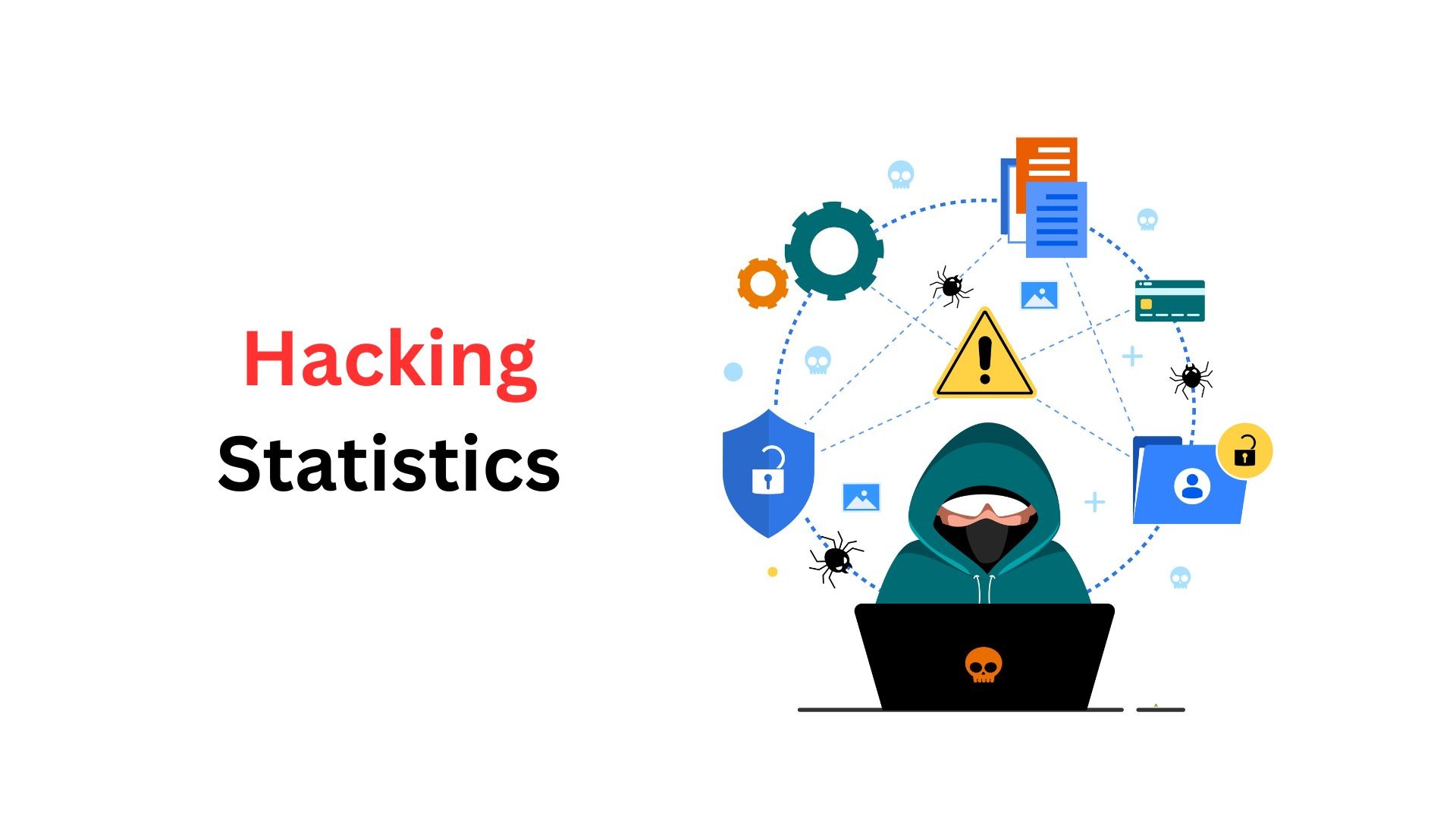Hacking Statistics and Facts By Type, Cost, Country, Industry, Demographic, Phishing And Social Media (2025)
Updated · Oct 08, 2025

Table of Contents
- Introduction
- Editor’s Choice
- Hacking Type Statistics
- Hacking Cost Statistics
- Hacking Statistics by Country
- By Industry, 2025
- Cost Per Data Breach Statistics by Country
- Hacking Victim Demographic Statistics
- Social Media Hacking Statistics
- By Financial Impact
- By Attack Success Rates
- Hacking Statistics by Phishing
- By Password Theft
- By Ransomware
- By Malware Attacks
- By DDoS Attacks
- By Social Engineering
- Growth Hacking Statistics in Real Time
- Conclusion
Introduction
Hacking statistics: In today’s connected world, hacking has turned into one of the biggest dangers for people, companies, and governments alike. It is a type of cybercrime where hackers break into networks, steal personal or financial information, and use ransomware to block access to important systems. Millions of records in sectors such as healthcare, finance, and public services are now at risk because of these attacks.
The harm goes beyond financial loss as it also breaks the trust people have in digital systems, which is why having strong cybersecurity has become essential. As technology grows more advanced, hackers also upgrade their methods, moving from tricks like phishing and stolen passwords to highly complex attacks often supported by state-level groups.
This article on Hacking Statistics shared all the latest facts, figures, and trends to help readers understand evolving threats, identify weak points, and explore effective strategies for building stronger defences in a fast-changing digital landscape.
Editor’s Choice
- According to Hoxhunt, in 2024, phishing remained the top attack vector, with approximately 64% organisations facing BEC and median losses of USD 150,000.
- A report published by Techreport states that the global financial impact of cybercrime, including hacking, is expected to rise from USD 9.22 trillion in 2024 to USD 8.15 trillion last year.
- In February 2024, the global average cost of a data breach reached USD 4.88 million, according to Statista.
- In 2025, the most common hacking methods are as follows: credential stuffing (31%), sophisticated phishing (27%), social engineering (18%), SIM swapping (14%), session hijacking (7%), and API exploitation (3%).
- In 2024, hacking statistics reveal that 22% of victims were aged 18 to 24, due to heavy social media use and unsecured Wi-Fi.
- In 2025, around 429 million social media accounts were hacked, with numbers expected to reach 580 million by year’s end, an increase of 34% compared to 2024.
- In the last quarter of 2024, the Anti-Phishing Working Group (APWG) reported 989,123 phishing incidents.
- In 2025, trackers revealed nearly 16 billion leaked credentials across various datasets.
- As of 2024, Cyberint recorded 5,414 ransomware attacks worldwide, about 11% higher than in 2023.
- In the same year, the world recorded more than 6.5 billion malware attacks, showing an 8% rise from the year before, as per Exploding Topics.
- In Q4 2024, Cloudflare reported that almost 6.9 million DDoS attacks had been stopped, which was 16% higher than the previous quarter.
- Nearly 98% of cyberattacks involve social engineering tactics like tricking or manipulating people, as noted by SentinelOne.
Hacking Type Statistics
- According to Hoxhunt, in 2024, the top attack vector was phishing, with approximately 64% organisations facing BEC and median losses of USD 150,000.
- Meanwhile, in Q1 of 2025, APWG recorded over 1,000,000 phishing attacks, with around 31% targeting financial/payment sectors.
- In 2024, ransomware surged with 5,600+ global incidents and only 28% of malware cases, reported by IBM X-Force and Fortinet.
- DeepStrike report states that in the first half of 2024, trackers observed around 236.7 million ransomware and malware attacks, driven by large-scale scanning and commodity malware.
- Verizon’s DBIR 2025 report shows 22,052 incidents and 12,195 breaches, with vulnerabilities and misconfiguration leading causes.
- In 2024, Bright Defence reported that the human factor caused about 60% to 70% of security incidents.
- Akamai reported that DDoS volumes and sophistication increased, with more multi-vector campaigns observed.
Hacking Cost Statistics

- A report published by Techreport states that the global financial impact of hacking will reach from USD 9.22 trillion in 2024 to USD 8.15 trillion last year.
- The cost of hacking will be USD 9.22 trillion by 2025, followed by 2026 (USD 11.36 trillion), 2027 (USD 12.43 trillion), and 2028 (USD 13.82 trillion).
Hacking Statistics by Country
- As of 2024, the United States recorded the most hacking incidents, about 1,240,000 cases, representing 28% of the global total.
Furthermore, other countries’ hacking incidents are mentioned in the table below:
|
Country |
Number of Incidents | Hacking Share |
| China | 980,000 |
22% |
|
Russia |
720,000 | 16% |
| India | 540,000 |
12% |
|
United Kingdom |
380,000 | 8% |
| Germany | 290,000 |
6% |
|
Brazil |
200,000 | 4% |
| India | 540,000 |
12% |
|
United Kingdom |
380,000 | 8% |
| Germany | 290,000 |
6% |
|
Brazil |
200,000 | 4% |
| Japan | 180,000 |
3% |
|
South Korea |
160,000 | 3% |
| Canada | 140,000 |
3% |
By Industry, 2025
| Industry | Hacking Method | Breach Rate | Average Financial Loss (USD) |
| Entertainment | Targeted phishing | 41% |
173,000 |
|
Technology |
API exploitation | 38% | 217,000 |
| Retail | Credential stuffing | 33% |
142,000 |
|
Finance |
SIM swapping | 29% | 274,000 |
| Healthcare | Social engineering | 26% |
189,000 |
|
Manufacturing |
Password spraying | 21% | 97,000 |
| Education | Malware attacks | 18% |
84,000 |
Cost Per Data Breach Statistics by Country

- In February 2024, the global average cost of a data breach reached about USD 4.88 million.
- In the same duration, the United States recorded the highest data breach cost at USD 9.36 million, followed by the Middle East at USD 8.75 million, Benelux at USD 5.9 million, while the global average stood at USD 4.88 million.
- Furthermore, other regions and countries average cost of a data breach from March 2023 to February 2024 arefollowed as Germany (USD 5.3 million), Italy (USD 4.73 million), Canada (USD 4.66 million), United Kingdom (USD 4.53 million), Japan (USD 4.19 million), France (USD 4.17 million), Latin America (USD 4.16 million), South Korea (USD 3.62 million), ASEAN (USD 3.23 million), Australia (USD 2.78 million), South Africa (USD 2.78 million), India (USD 2.35 million) and Brazil (USD 1.36 million).
Hacking Victim Demographic Statistics
- In 2024, hacking statistics showed that about 22% of hacking cases involved people aged between 18 and 24 years.
- Moreover, the 25 to 34 years age group is known as the highest victims of hacking at 29%, while 21% (35 to 44 years), 15% (45 to 54 years), and 13% (55 years and older).
- Men were behind most financial scam hackings, making up 55%, while women accounted for 45%, often through social trick methods.
- Looking at regions, North America faced the largest share with 40% of hacks, followed by Europe at 30%.
- The Asia-Pacific region had 20%, and Africa and South America together made up the remaining 10%.
Social Media Hacking Statistics

- In 2025, around 429 million social media accounts were hacked; those are expected to reach 580 million by year’s end, an increase of 34% compared to 2024.
- Most incidents happened on Instagram (31%), followed by Facebook (27%), LinkedIn (18%), Twitter/X (14%), TikTok (6%), and other platforms (4%).
- Once hacked, about 73% of users saw their accounts on multiple platforms compromised.
- On average, it takes 17 days for people to regain control of their accounts fully.
By Financial Impact
- According to hackingloops.com, as of 2025, social media hacking caused heavy losses, with direct damages reaching about USD 14.7 billion from fraud and stolen funds.
- Companies saw an average 23% drop in revenue the month after a major account breach.
- Recovering from such incidents costs organisations nearly USD 97,000 on average.
- Hackers targeting high-profile accounts demanded ransoms of around USD 21,400.
- Public companies faced a 3.7% stock drop within two days after social media account compromises.
By Attack Success Rates
- Hacking Statistics also states that Phishing tricks succeed with 27% of users giving away login details on fake social sites.
- Password spray attacks break into 9.3% of accounts by trying common patterns.
- Even multi-factor authentication is bypassed in 14% of cases using smart scams.
- Around 43% of hacked social accounts start with reused passwords from older breaches.
- Automated bots are also active, making nearly 1.7 million login attempts on social platforms every day.
Hacking Statistics by Phishing
- In the last quarter of 2024, the Anti-Phishing Working Group (APWG) reported 989,123 phishing incidents, with monthly cases ranging from about 290,000 to 358,000.
- In the first quarter of 2025, phishing cases stayed high, reaching 1,003,924 incidents.
- In 2024, the FBI’s Internet Crime Complaint Centre (IC3) received 859,532 reports of online crimes.
By Password Theft
- By the end of 2025, trackers are expected to reveal almost 16 billion leaked credentials across various datasets.
- Industry reviews indicate that about 49% of breaches involve compromised passwords.
- Human actions remain a big factor, with 68% of incidents linked to mistakes or phishing, according to Bright Defence.
- Studies also highlight that more than 80% of people reuse passwords, and weak or short ones are often exploited, as Demand Sage reports.
By Ransomware
- In 2024, Cyberint recorded 5,414 ransomware attacks worldwide, about 11% higher than in 2023.
- The final quarter alone saw 1,827 cases, nearly a third of the year’s total.
- Rapid7 reported 5,939 leak-site posts, while Corvus confirmed 1,663 victims in Q4.
- Healthcare suffered 181 breaches, exposing 25.6 million records, with ransom demands averaging USD 5.7 million but payments closer to USD 900,000.
- By 2025, Exabeam noted 378 U.S. cases in five weeks, Industrial Cyber found 2,472 Q1 victims, and Rapid7 tracked 96 active groups.
By Malware Attacks
- In 2024, the world recorded more than 6.5 billion malware attacks, showing an 8% rise from the year before, as per Exploding Topics.
- Spacelift shared that each day, between 450,000 and 560,000 new malware samples were spotted.
- By the end of the year, the global total of unique malware files went past 1.2 billion.
- Check Point Blog further stated that in Q3 of 2024, global companies faced around 1,876 cyberattacks, resulting in an increase of 75%.
- Securelist noted that in Q1 2025, local malware affected 13.62% of Kaspersky users’ computers.
- Meanwhile, attackers exploited 161 vulnerabilities, surpassing CISA’s KEV list of 136.
By DDoS Attacks
- In Q4 2024, Cloudflare reported stopping 6.9 million DDoS attacks, which was 16% higher than the previous quarter and 83% more than a year earlier.
- During Q3 2024, DDoS activity grew 49% from last quarter and 55% compared to the same quarter in 2023.
- In Q1 2025, around 20.5 million DDoS attacks occurred, showing a 358% increase year over year and 198% quarter-over-quarter growth.
- Out of those blocked in Q1 2025, about 16.8 million were network-layer attacks, showing a sharp rise in lower-layer targeting.
- In 2024, Cloudflare reported that nearly half of blocked attacks were at the network layer, while slightly more occurred at the application layer.
- DDoS incidents usually lasted 23 minutes, peaking at 1.6 Tbps.
By Social Engineering
- Almost 98% of cyberattacks use social engineering, where criminals trick or manipulate people, says SentinelOne.
- Incident reports reveal that 60% of data exposure cases came from such attacks.
- In 2024, more than 4 million mobile-based social engineering attempts occurred.
- Studies suggest that 70% to 90% of data breaches had some link to social engineering.
- On average, businesses now deal with over 700 social engineering attacks every year, according to Splunk.
Growth Hacking Statistics in Real Time
- According to MyCodelessWebsite, around 53,000 people type “growth hacking” into Google every month, with France being the country where it is most popular.
- In the past two years, the number of “growth hacking blogs” listed on Google jumped by 138.035%.
- One article on this subject became especially popular, reaching 26,800 shares on Twitter.
- By April 12, 2024, searching “What is growth hacking?” on Google gave about 193 million results within 0.27 seconds.
- On LinkedIn, profiles offering growth hacking services increased by 171.43% in 2025.
- With 5.17 billion global users in 2024, it provides strong support for campaigns.
- Ideally, growth hacking strategies aim for a 12.5% average engagement rate on social networks.
- For example, Google Analytics holds a rating of 4.5 out of 5 among growth hackers.
- Email marketing remains another essential channel, with daily emails projected to rise by an astonishing 8,966.67% by 2027.
- Collaborating with industry influencers can also help, often pushing sign-ups higher by over 160,000.
- Over 55% begin with freelancers, but about 39% later shift to agencies for deeper expertise.
- Only 8% stick with freelancers for more than two rounds.
- Meanwhile, 30% of startups choose agencies from the start, and 20% eventually move work in-house to reduce costs.
- Most companies (64%) adopt growth hacking mainly for lead generation.
Conclusion
Hacking statistics concluded that hacking has become a fast and dangerous cyber threat in today’s technologically connected world. Hackers often look for the weakest spots in digital systems, using methods like data breaches and ransomware to harm different industries and endanger millions of people. The damage is not only about financial losses but also about losing trust in online platforms.
As technology advances, cybercriminals also become smarter and develop new tricks to break in. For this reason, individuals, companies, and governments need to stay alert, improve security measures, and encourage safe online habits to lower the risks ahead.
Sources
FAQ.
Phishing, password theft, ransomware, malware attacks, denial-of-service (DoS), and social engineering.
Every year, hacking causes global losses of several trillion U.S. dollars, and costs keep rising.
White-hats test with permission, grey-hats disclose without consent, black-hats exploit for gain & cause harm, and script kiddies copy others’ tools.
Smartphones are the top target, because so many people use them and store private information.
Ethical hackers use tools such as Nmap, Metasploit, Wireshark, and Burp Suite to test systems.

Maitrayee Dey has a background in Electrical Engineering and has worked in various technical roles before transitioning to writing. Specializing in technology and Artificial Intelligence, she has served as an Academic Research Analyst and Freelance Writer, particularly focusing on education and healthcare in Australia. Maitrayee's lifelong passions for writing and painting led her to pursue a full-time writing career. She is also the creator of a cooking YouTube channel, where she shares her culinary adventures. At Smartphone Thoughts, Maitrayee brings her expertise in technology to provide in-depth smartphone reviews and app-related statistics, making complex topics easy to understand for all readers.










